ILC's Treatment for
Lumbar Disc Herniation
Having been adopted in over 54 countries globally,
the "Cellgel Method" for treating lower back pain
is now available in Japan
For those who have been told it was impossible to operate,
For those who have had recurrence of pain post-surgery,
A low-risk, outpatient treatment is now an option for you.
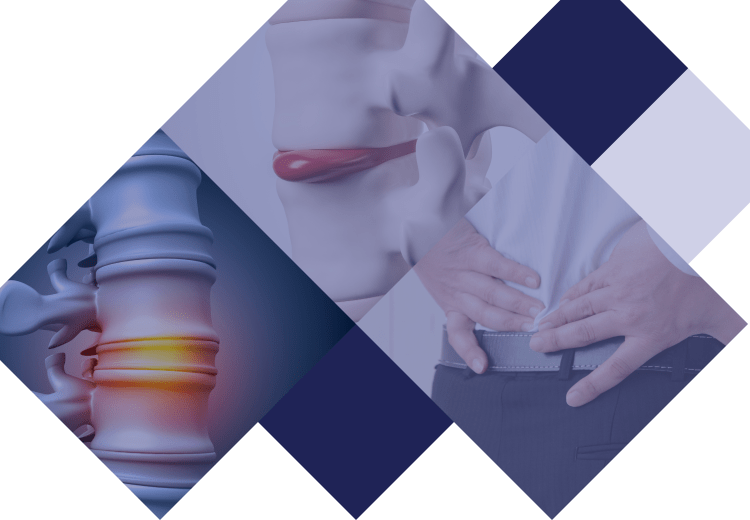
Contents
 Table of Contents
Table of Contents
This page provides information on the main symptoms and causes of herniated discs and our treatment procedures. The information includes the method of treatment, treatment time, and information about insurance. We use the Cellgel method, which is one of the most advanced methods in the world, and the characteristics of this method are also described in detail.
Please read this page especially if you have been told that you cannot be cured without surgery, if you have had surgery in the past but have not improved, or if you got better after surgery but the symptoms have recurred.
What is disc herniation?
What is disc herniation?
The intervertebral disc, simply put, is a disc that exists between the bones in the spine. The disc has a gelatinous center called the nucleus pulposus, and a collagen-rich ring of fibers ('annulus fibrosus') surrounding it. The intervertebral disc is made up of two tissues, the nucleus pulposus and the annulus fibrosus. A herniated disc is a condition in which the nucleus pulposus protrudes outward due to a fissure in the annulus fibrosus.
There are two main types of herniated discs:
- 1 Protrusion: Cracks in the annulus fibrosus, the nucelus pulposus moves back and compresses the spine, but does not leak
- 2 Extrusion: The annulus fibrosus cracks and the nucleus pulposus breaks through, directly compressing the nerve


Main symptoms of disc herniation

The main symptoms are pain and numbness in the buttocks and legs; feeling weakness and difficulty in moving them. Pain and numbness can occur anywhere in the lower body, but pain from the buttocks to the back of the thighs is called sciatica and is a typical symptom of lumbar disc herniation.
The spine might tilt to one side, making it difficult to move, and the pain may be more severe when lifting heavy objects. Symptoms may come on suddenly or gradually.
If the nerve is severely compressed, it may cause difficulty in passing or holding urine or stool.
What causes disc herniation?
The main cause is deterioration of the intervertebral disc due to genetic factors, aging, and the strain of daily life.
Originally, the nucleus pulposus in the intervertebral disc is filled with water. As time passes, the nucleus pulposus leaks out of the annulus fibrosus due to cracks and the loss of water, leading to a thin and collapsed disc. Lifting heavy objects in daily life or engaging in strenuous sports activities in particular can cause disc damage. X-rays and MRIs also show the disc as black and collapsed.
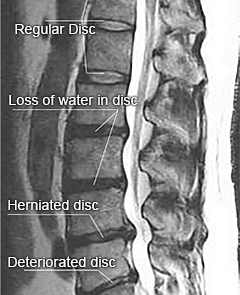
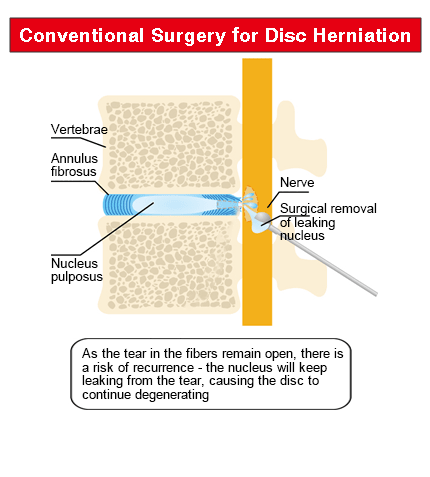
Surgical procedures do not provide fundamental treatment of the disc.
It has long been a mystery why some severe hernias do not cause pain, while others, even mild hernias, cause severe pain. Inflammation of the displaced nucleus pulposus can spontaneously disappear after a certain period of time (several months). Similar to when you light a piece of wood; it burns intensely but when it goes out, the charcoal remains. Some hernia - like charcoal - remain and will look severe on an MRI scan, but it has no symptoms because it is past the inflammatory stage.
Pain from a herniated disc is not caused by physical nerve compression from an already prolapsed nucleus pulposus, but by inflammation from a freshly prolapsed nucleus pulposus.
In other words, a person who has persistent pain for several months or longer means that new nucleus pulposus is constantly leaking, while a person whose pain has improved means that the nucleus pulposus has stopped leaking. This is very important, because surgical removal of the leaking nucleus removes the inflammation, but does not seal the cracks in the annulus fibrosus, causing the nucleus to continue leaking and resulting in a high recurrence rate.
Why is the recurrence rate so high?
Conventional surgical methods relieve symptoms by removing the herniated disc that has protruded, but since the cracks in the disc are not repaired, the disc may herniate again.
This is the main cause of recurrence, which is why it is said to be a disease that is difficult to cure completely.
The Cellgel method used at our clinic injects a drug that fills the cracks in the disc, which then forms a gel that replaces the cracks, thereby providing a fundamental cure to the root cause.
Conventional Surgery

Only the protruding part of the disc is removed via endoscopic surgery.
The damage to the fibers are not repaired.
Cellgel Method
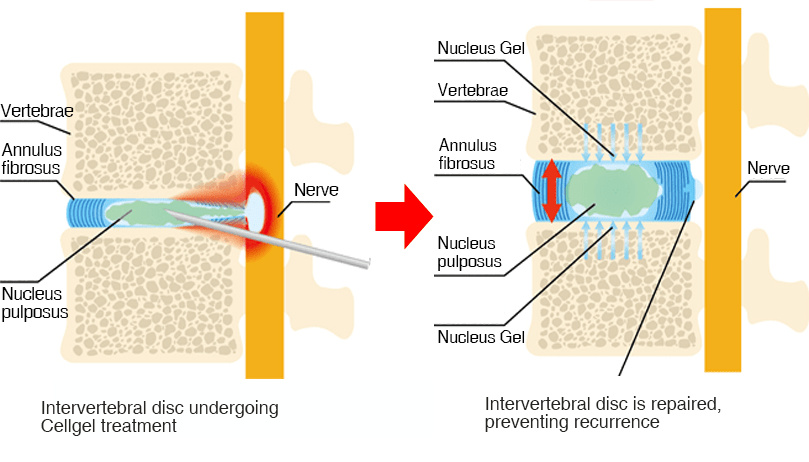
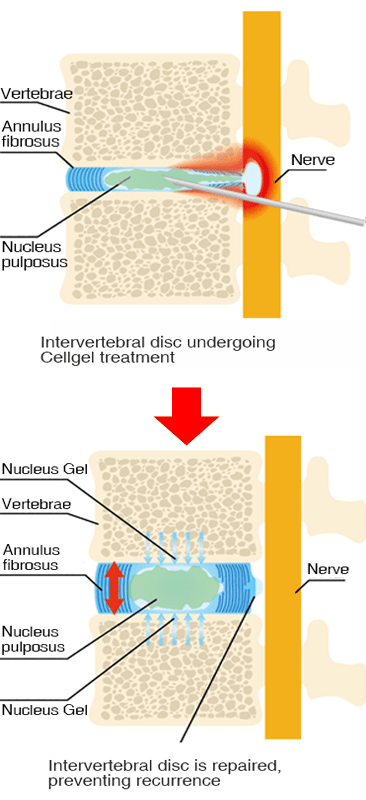
Since many of our patients come from far away,
we are happy to give free consultations to see which treatment is best for you
We'll diagnose your MRI images for free!
Treatment at ILC
There are four main treatments at our clinic.
As mentioned above, the root cause of each back pain disease is "inflammation and deformation due to aging of the intervertebral discs." Although the four treatment methods have different features and advantages, we would like to first introduce the "Cellgel method," which is the only one capable of intervertebral disc repair.
The Cellgel Method
About Cellgel
The Cellgel method is an advanced treatment for low back pain that has been implemented in more than 54 countries worldwide, predominantly in Europe.
As with other treatments, it does not decrease the disc volume, and since the drug remains in the disc as a gel-like implant after treatment, the disc can be preserved. Recent studies have also shown that the volume of the disc increases after treatment.*1
It is also thought that by repairing the disc and preventing leakage of the Nucleus Pulposus, the disc itself will restore its normal function with its own regenerative ability (*2).
It is particularly recommended for patients who are concerned about the risk of conventional disc surgery (MED, PELD, etc.).
*1 Source: European Journal of Radiology 109 (2018) 101–107 , Efficiency of an ethyl alcohol gel in symptomatic disc hernation
*2 Source: International Journal of Spine Surgery Vol. 15 Appendix 1 from regenerative treatment of disc degeneration
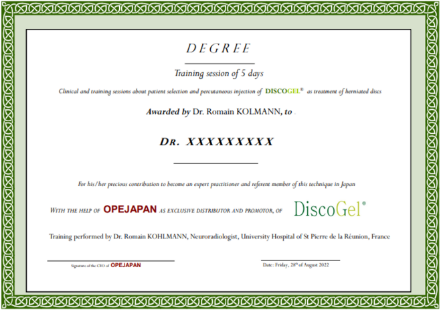
"Very good or good results were obtained in 202 (91.4%) of the 221 patients in group A. Of the 44 patients in group B, 37 patients (84%) presented very good or good results and in 9 (82%) of the 11 patients of group C, we obtained similar results. There was no allergic complication in any of our patients. Long-term follow-up magnetic resonance showed a dramatic reduction in hernia volume."
- Dr. J. Theron, one of the world's leading experts in the treatment of Celgel method, from his research article "Percutaneous Treatment of Lumbar Intervertebral Disk Hernias With Radiopaque Gelified Ethanol - A preliminary study."
Merits of Cellgel
- Possibility to repair intervertebral discs where unable to using surgical or laser treatment
- As the disc is repaired, the disc itself regains its original normal function through its own regenerative ability
- The Cellgel method uses local anesthesia over general anesthesia used in conventional surgery, making it less burdensome on the body
- Treatment is done with a thin needle, so the wound is minimal and recovery is rapid
- Treatment is very short, allowing for outpatient day treatment
- Safe, modern treatment proven in more than 54 countries around the world
Flow Cellgel Treatment Process
-
01 Examination
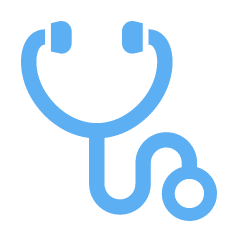
MRI and X-rays will be taken, followed by a doctor's diagnosis.
If the diagnosis proves the Cellgel method suitable, treatment can begin that same afternoon. -
02 Before

TreatmentAfter entering the treatment room and administering local anesthesia to the lower back, a needle is inserted into the intervertebral disc identified in the examination.
A contrast scan is performed to confirm the location of the damaged disc. -
03 Treatment
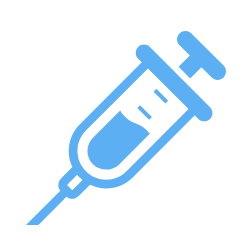
The Cellgel drug is administered to the damaged area while confirming the location of the disc with a fluoroscopy device.
Once the drug has been absorbed, the needle is removed and the bleeding is stopped.
-
04 Returning

HomeAfter the treatment, the patient rests in a private room for about an hour, and then allowed to go home after the post-treatment examination.
*Resting time depends on the patient's symptoms and condition.
Price Cost of Treatment for the Cellgel Method
| Number of Discs Treated |
1 disc | 2 discs | 3 discs | 4 discs | 5 discs |
|---|---|---|---|---|---|
| Treatment Cost | 1,320,000 JPY | 1,430,000 JPY | 1,540,000 JPY | 1,650,000 JPY | 1,760,000 JPY |
Swipe left/righ
* The cost of treatment is indicated including taxes.
*If treatment is performed at our clinic, all examination/diagnosis costs and test costs such as MRI are included in the above costs.
*This treatment method is not covered by Japanese health insurance, so you will have to pay for the entire treatment yourself.
*Payment by credit card (VISA, MasterCard, JCB, American Express, Diners, Discover) is also possible.
*If you would like rehabilitation (low back pain specialized rehabilitation), it is also possible to pay by bank transfer.
*If you live and work in Japan, you can receive a tax refund by filing your final medical expense return.
FAQ Questions about lumbar disc herniation and treatment
-
QWhat's the difference in the reccurence rate between Cellgel and conventional surgery?
-
A
Surgical procedures, which began in the 1960s, aimed to remove and sometimes fix deformed bones and herniated tissue. However, new bone damage caused by screws and the lack of fundamental treatment (repair of the intervertebral disc annulus fibrosus) resulted in the appearance of additional back pain and recurrence rates.
Therefore, in the 1980s, the need for fundamental treatment increased, and the intervertebral disc treatment (Cellgel) that we provide at our clinic began. Cellgel, in particular, have been proven to repair and regenerate the intervertebral disc, resulting in not only improvement of symptoms, but also an extremely low recurrence rate.
-
QHow is the disc to be treated determined?
-
AThe doctor will spend about 30 minutes with the patient while looking at the MRI and X-ray images to determine the cause of the condition, determine the treatment area, and explain the corresponding treatment method to the patient. MRI images show the main factors that contribute to back pain (disc, nerve, ligament, and joint), such as changes in shape, pressure on the nerve, presence or absence of damage, and inflammation. The x-ray image mainly confirms the condition of the bones.
-
QWhy is the Cellgel method applicable to cases where surgery showed no improvement?
-
ADuring surgery for disc herniation, the prolapsed herniation is removed, but the damaged disc remains intact. As a result, fresh nucleus pulposus components leak from the damaged disc and inflammation persists. On the other hand, our treatment can treat the disc injury itself, thus suppressing inflammation by reducing the fresh leakage of nucleus pulposus components.
-
QMy back pain may temporarily worsen after treatment. How long will it last?
-
AThe reason for the lower back pain is that spinal ligaments that have been compressed are stretched; the lower back pain lasts for about two weeks and then subsides.
-
QWhat level of exercise can I perform after treatment?
-
AGeneral recreational exercise and sports can be done without any problem. For professional athletes, the possibility of new disc damage is high and should be discussed in consultation with a doctor.
-
QPlease tell me about what I should be cautious about after treatment.
-
ADuring the first few days after treatment, the patient should rest and avoid prolonged sitting, heavy lifting, twisting, bending, or strenuous exercise. Patients should be able to perform routine tasks one week after treatment and should be able to perform light exercise by the second week. Weight training is allowed after 3 months.
-
QIs the treatment covered by the Japanese national health insurance?
-
ANo, it is not covered by the national insurance. If you have life insurance, you may be eligible. Please feel free to consult our staff regarding this matter.
-
QHow long must I wait to be able to walk after treatment?
-
AIt is an outpatient/day treatment, so you can walk about an hour after the surgery.
-
QHow many doctor visits do I need to make before treatment?
-
AWe require an MRI to be taken within three months for remote diagnosis, either with our affiliated clinic or from data sent by you. You can receive treatment on the same day after phyiscal diagnosis. You may also request only the diagnosis and come back only for the treatment at a later date.
-
QCan I fly immediately after the treatment?
-
AIf there are no problems after the treatment, you may fly. If there is any pain after the treatment, flying may not be recommended depending on the doctor's evaluation.
-
QHow is disc herniation diagnosed?
-
A
The results of the current symptoms, past history, and physical examination are used to make a comprehensive diagnosis through a thorough examination with MRI scan and X-ray.
An MRI scan is effective in visually confirming the herniation; it reveals the location, size, shape, and nerve compression of the herniated disc, and confirms whether it will be easily resolved if left untreated, and if so, what kind of treatment would be appropriate. However, MRIs may not be able to detect small hernias depending on machine capabilities and the technique used. Even if a herniation is detected, there may be another cause of the numbness or pain. It is possible to be told that the disc is not herniated, but in fact it is a small herniation, or to be told that the disc is herniated but in fact it is another disease.
Please consider having a diagnosis with us first.
-
QHow long must I wait to be able to walk after conventional surgery?
-
ADepending on the surgical procedure, removal procedures such as PELD/MED will require a hospital stay of 2-3 days.
After that, the patient can return home. The Cellgel method and other treatments that we perform at our clinic are outpatient treatments, so you can walk about an hour after the surgery.
-
QDo I need rehabilitation after the Cellgel treatment?
-
A
Rehabilitation can help improve the effectiveness of treatment.
Resting too much after treatment can also decrease mobility, so we recommend moderate walking and light stretching.We also provide exercise instructions on the day of treatment, so please feel free to ask us about postoperative exercises.
-
QIs disc herniation dangerous?
-
ADepending on the individual, symptoms can often be severe, causing difficulty in sitting, walking, and other symptoms.
The first and most important step is to diagnose back pain and find the appropriate treatment.
-
QWhat happens if I just leave my disc herniation as it is?
-
AA herniated disc is a condition in which symptoms disappear and may heal spontaneously.
A herniated disc will not repair or regenerate, but it may shrink or disappear.
Before considering surgery, we try to monitor changes in symptoms and suggest the least invasive treatment.
-
QIf the disc herniation has been removed, will there still be recurrence?
-
AAlthough a single removal may relieve pain, there is a possibility that the nucleus pulposus in the disc may leak out from the removed area and cause recurrence.
Only the Cellgel method can reduce the risk of recurrence by healing the disc itself.
-
QAm I still eligible for the Cellgel method if I've undergone surgery before?
-
AYes, it is possible.
We use a thin needle for our procedures, so we can provide treatment even after surgical procedures.
We will first perform an examination and consultation to diagnose the best treatment option.
-
QIf I've been diagnosed with disc herniation, should I exercise less?
-
AModerate exercise is necessary unless the pain is so severe that exercise is not possible. Lack of exercise may cause the body's muscles to weaken and the pain to become more severe.
Learning how to exercise properly may relieve symptoms. Our clinic is affiliated with a rehabilitation facility that specializes in back pain and strives to improve the root cause of back pain.
-
QWhat should I be cautious of after treatment for lumbar disc herniation?
-
A
After treatment for disc herniation at our clinic, you may go home on the same day, but we recommend that you wear a back-support corset around your waist and rest.
We also recommend that you refrain from strenuous exercise for about one month, but do moderate walking and stretching.
ILC Rehabilitation X Disc Herniation Treatment
Although the Cellgel method can repair and regenerate the disc itself, and other treatment methods we offer can fundamentally heal the disc; it is possible that the cause of back pain is not only the disc, but also muscles, joints, and ligaments that are affected by the disc.
In cooperation with our rehabilitation specialists, we recommend treating back pain caused by muscles, joints, and ligaments together.
We also offer a short-term intensive program for patients who live far away or overseas.
-
ILC's Low Back Pain Treatment
Outpatient Treatment
Improve back pain disorders/
symptoms in relation to the nerves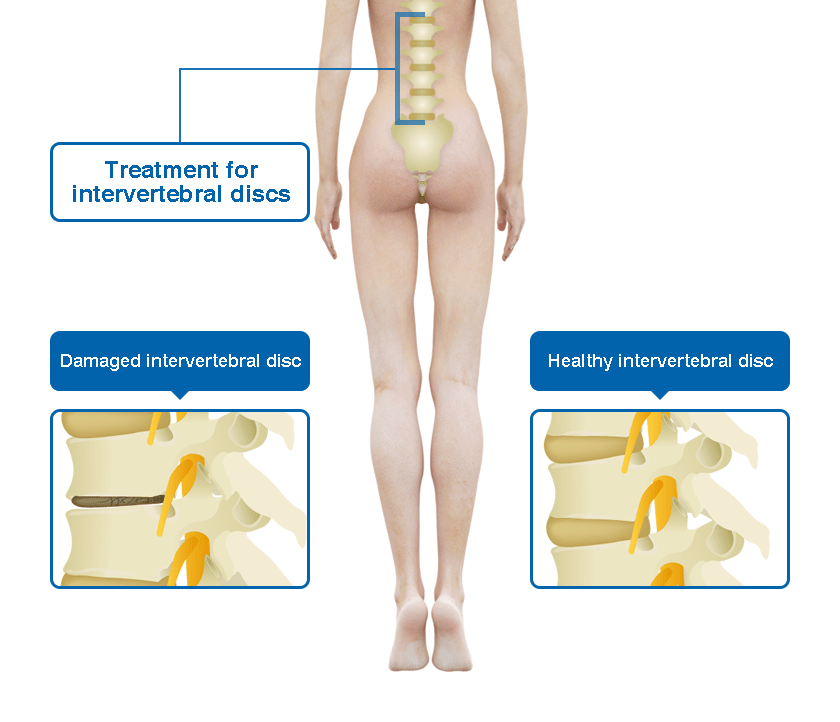
-
ILC's Rehabilitation Program
Specialized Low Back Pain Rehabilitation
Improve back pain disorders/symptoms in
relation to the joints, muscles, ligaments
-
01
ILC's Specialized Back Pain Rehabilitation
Our Rehabilitation Approach to Disc Herniation
Disc herniation is caused by cracks resulting from degeneration of the intervertebral disc. Discs are found to be at risk of being damaged due to repeated mechanical stresses such as excessive compression on the disc, aging, and lifestyle habits such as smoking and diet. Damaged discs are more likely to irritate the nerves that cause pain, and their cushioning function becomes less functional. This reduced cushioning adversely affects the intervertebral joints, vertebrae, and other surrounding tissues.
Although rehabilitation is possible even when the cushioning function is impaired, rehabilitation cannot repair disc fissures or enhance the cushioning function, and can only prevent the disc from degenerating further by decreasing burden on the disc.
Therefore, at our rehabilitation center, we believe it is very important to both repair the function of the intervertebral disc and then conduct rehabilitation to prevent recurrence.
In addition, our rehabilitation program also includes a review of lifestyle, such as diet, to prevent the deterioration of intervertebral discs. -
02
ILC's Specialized Back Pain Rehabilitation
How to Evaluate Disc Herniation
To understand the site of the damage caused by disc herniation, the degree of damage and the condition of surrounding tissue, a consultation with the doctor will be conducted based on the image (MRI) findings.
Using the findings as a reference, we will evaluate the aggravating and mitigating factors of the symptoms in the posture and movements of daily life while actually moving the body slowly. Aggravating factors are defined as movements that should not be performed, and mitigating factors are symptoms that can be alleviated by doing certain body movements. We will comphehensively evaluate these factors with muscle strength and stiffness, and explore the nature of the symptoms.
In addition, since inflammation is very closely related to the state of the physical body, we will also conduct a medical interview and evaluate the level of oxidative stress to evaluate the factors contributing to inflammation.
-
03
ILC's Specialized Back Pain Rehabilitation
Rehabilitation Treatment for Disc Herniation
Firstly, it is important to fundementally repair the damaged disc. However, while doing so is highly effective for pain and numbness, it does not directly address the risk of recurrence (muscle weakness, joint range of motion, etc.).
Therefore, it is important for our rehabilitation facility to focus on preventing recurrence, not just alleviating the symptoms that are currently present.
*Even when a disc is repaired, it will never return to 100% of its previous state.As lumbar disc herniation is caused by the disc being overloaded due to poor posture and muscle weakness, rehabilitation is based on evaluation and imaging scans, and begins with a low-impact, low-load practices for the disc and surrounding tissues.
Traditional Chinese medicine such as acupuncture, electro-acupuncture, and moxibustion are also used to treat pain, nerve inflammation, and numbness.
-
04
ILC's Specialized Back Pain Rehabilitation
Treatment Period for Disc Herniation Rehabilitation
Although it varies from each individual, inflammation of lumbar disc herniation tends to ease in about one to two weeks, and majority of the pain is eased after three months if there is no numbness after the Cellgel method combined with rehabilitation.
If the pain persists even after the inflammation from the hernia has subsided, it may be due to the muscles and surrounding tissues. It takes two weeks to two months to retrain the muscles and gain musclar strength whilst correcting the posture. It is recommended that the rehabilitation treatment period for lumbar disc herniation should include an intensive rehabilitation period of at least two weeks and maintenance once or twice a month. After that, we will instruct you on self-care with the goal of establishing the muscles necessary for body use and posture. Be careful not to interrupt rehabilitation at on your own in attempts to maintain muscle strength.
In the case of numbness, however, what happens after treatment will depend on the time that has passed since the symptoms appeared.
It is easy to alleviate the symptoms if you've only experienced it for six months, but the longer it's been left untreated, the more difficult it is to get back to the previous state. It tends to take at least three to six months for symptoms to settle down, or more than a year for some people, but it is difficult to estimate the exact time it wil take to treat the condition.
Many other factors are involved, such as whether the nerves are damaged, whether there is any sensory loss due to paralysis, and whether there is motor paralysis. Regular rehabilitative maintenance will be essential.
We aim to achieve 100% effectiveness of treatment while incorporating the latest technology, so we spend at least 30 minutes with each patient to carefully and meticulously examine the patient's concerns in order to make a proper diagnosis and propose the most suitable treatment methods.
We are certain to find a way to alleviate or eliminate the pain and numbness you are experiencing, so please do not give up and give us a call instead!
- Tadaaki Minowa, Clinic Director



